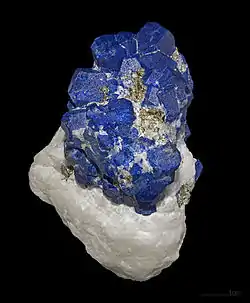| Lazurite | |
|---|---|
 Lazurite, Ladjuar Medam (Lajur Madan; Lapis-lazuli Mine), Sar-e-Sang District, Koksha Valley (Kokscha; Kokcha), Badakhshan (Badakshan; Badahsan) Province, Afghanistan | |
| General | |
| Category | Tectosilicate |
| Formula (repeating unit) | (Na,Ca)8[(S,Cl,SO4,OH)2|(Al6Si6O24)] |
| IMA symbol | Lzr[1] |
| Strunz classification | 9.FB.10 |
| Crystal system | Isometric |
| Crystal class | Hextetrahedral (43m) H-M symbol: (4 3m) |
| Space group | P43n |
| Unit cell | a = 9.09 Å; Z = 2 |
| Identification | |
| Color | Deep blue, azure, violet-blue, greenish blue |
| Crystal habit | Crystals occur as dodecahedra, or rarely cubes; granular, disseminated, or massive |
| Cleavage | Imperfect on {110} |
| Fracture | Uneven |
| Tenacity | Brittle |
| Mohs scale hardness | 5–5.5 |
| Luster | Vitreous |
| Diaphaneity | Translucent to opaque |
| Specific gravity | 2.38–2.45 |
| Optical properties | Isotropic; anomalously anisotropic |
| Refractive index | 1.502–1.522 |
| Fusibility | 3.5 |
| Solubility | Soluble in HCl |
| References | [2][3][4][5][6] |
Lazurite is a tectosilicate mineral with sulfate, sulfur and chloride with formula (Na,Ca)8[(S,Cl,SO4,OH)2|(Al6Si6O24)]. It is a feldspathoid and a member of the sodalite group. Lazurite crystallizes in the isometric system although well‐formed crystals are rare. It is usually massive and forms the bulk of the gemstone lapis lazuli.
Mineral
Lazurite is a deep‐blue to greenish‐blue. The colour is due to the presence of S−
3 anions.[7] It has a Mohs hardness of 5.0 to 5.5 and a specific gravity of 2.4. It is translucent with a refractive index of 1.50. It is fusible at 3.5 on Wolfgang Franz von Kobell's fusibility scale, and soluble in HCl. It commonly contains or is associated with grains of pyrite.
Lazurite is a product of contact metamorphism of limestone and is typically associated with calcite, pyrite, diopside, humite, forsterite, hauyne and muscovite.[2]
Other blue minerals, such as the carbonate azurite and the phosphate lazulite, may be confused with lazurite, but are easily distinguished with careful examination. At one time, lazurite was a synonym for azurite.[5]
Lazurite was first described in 1890 for an occurrence in the Sar-e-Sang District, Koksha Valley, Badakhshan Province, Afghanistan.[3] It has been mined for more than 6,000 years in the lapis lazuli district of Badakhshan. It has been used as a pigment in painting and cloth dyeing since at least the 6th or 7th century.[8] It is also mined at Lake Baikal in Siberia; Mount Vesuvius; Burma; Canada; and the United States.[8] The name is from the Persian lajvard for blue.[9]
Structure
Lazurite and hauyne seem to have the same structure and both are sulfate-dominant minerals.[10] Lazurite is a pigment (opalescent) and has a bright blue streak (especially as a component of the semiprecious stone lapis lazuli). Many hauynes have a white or pale blue streak and are translucent. The difference might be a consequence of the redox state (sulfate to sulfide ratio).[7][11]
See also
- Hauyne – Silicate mineral
- Ultramarine – Deep blue purple color pigment which was originally made with ground lapis lazuli
References
- ↑ Warr, L.N. (2021). "IMA–CNMNC approved mineral symbols". Mineralogical Magazine. 85 (3): 291–320. Bibcode:2021MinM...85..291W. doi:10.1180/mgm.2021.43. S2CID 235729616.
- 1 2 Handbook of Mineralogy
- 1 2 Mindat with location data
- ↑ Webmineral data
- 1 2 Hurlbut, Cornelius S. and Klein, Cornelis, 1985, Manual of Mineralogy, 20th ed., Wiley, p. 459 ISBN 0-471-80580-7
- ↑ "Mineralogical Society of America" (PDF). Archived from the original (PDF) on 2016-03-03. Retrieved 2011-03-08.
- 1 2 Tauson VL, Sapozhnikov AN (2003). "On the nature of lazurite coloring" (PDF). Zapiski Vserossijskogo Mineralogicheskogo Obshchestva (in Russian). 132 (5): 102–107.
- 1 2 Eastaugh, Nicholas; et al. (2004). The Pigment Compendium: Optical Microscopy of Historical Pigments. Oxford: Elsevier Butterworth-Heinemann. p. 219. ISBN 0-7506-4553-9.
- ↑ "Tile fragment". Victoria and Albert Museum. Retrieved 11 January 2020.
- ↑ Moore, T.P.; Woodside, R. W. M. (2014). "The Sar-e-Sang Lapis Mines". Mineralogical Record. 45 (3): 281–336.
- ↑ Hettmann K, Wenzel T, Marks M, Markl G (2012). "The sulfur speciation in S-bearing minerals: New constraints by a combination of electron microprobe analysis and DFT calculations with special reference to sodalite-group minerals". American Mineralogist. 97 (10): 1653–1661. Bibcode:2012AmMin..97.1653H. doi:10.2138/am.2012.4031. S2CID 54921328.
External links
 Media related to Lazurite at Wikimedia Commons
Media related to Lazurite at Wikimedia Commons